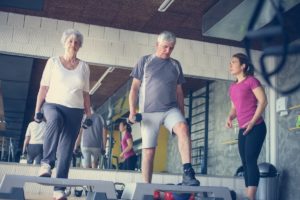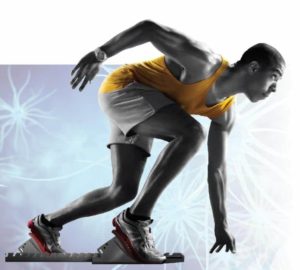Chronic Diseases
Highly Fit Women and Dementia
Middle-aged women with high cardiovascular fitness levels were almost 90% less likely to develop dementia in older age than women with moderate aerobic fitness, according to a recent study in the journal Neurology (2018; doi:
10.1212/WNL.0000000000005290).
To Fight Diabetes, Jump on the Whole-Grain Train
The numbers are startling: About 30 million Americans—more than 9% of the population—have diabetes, according to the Centers for Disease Control and Prevention. Another 84 million have prediabetes, a condition of poor blood sugar control that often leads to type 2 diabetes. But it looks like adding whole grains to our diets could reduce the disease’s collective burden.
The Optimal Amount of Exercise for Heart Health
Arterial stiffness, which increases with sedentary living, is associated with higher risk of heart disease. It’s well known that exercise can help, but how much—or how little—is enough?
“While near-daily, vigorous lifelong (>25 years) endurance exercise training prevents arterial stiffening with ageing, this rigorous routine of exercise training over a lifetime is impractical for most individuals,” noted the authors of a new study, which aimed to determine the least amount of exercise necessary to reduce arterial stiffness.
Exercise Doesn’t Slow Dementia, Say Researchers
Research has supported exercise as having the potential to keep dementia at bay or at least to impede its progression. A recent study suggests that physical activity may not be as effective at warding off cognitive decline as previously thought.
In this study, published in BMJ (2018; 361, k1675), 329 individuals were assigned to an exercise intervention, while 165 subjects received “usual care.” Average age was 77, and each participant had a clinically confirmed dementia diagnosis.
Weight Training’s Surprising Effects on Depression
Could a cure for depression be found in the weight room? Data from a study published in JAMA Psychiatry (2018; 75 [6], 566–76) points to that conclusion. The meta-analysis of 33 clinical trials, featuring 1,877 participants, found a link between resistance training (RET) and a reduction in depressive symptoms.
Food, Not Pills
Count this as more proof that we shouldn’t rely on pills and powders to make up for dietary shortfalls.
Plant Foods Are Good for Our Gut Bugs
Our bodies host a huge population of microorganisms, dubbed the human microbiome. In recent years, the makeup of critters in our guts has been linked to a plethora of conditions, including depression, heart disease and obesity. And now bug-friendly scientists at the University of California, San Diego School of Medicine have presented initial findings from the American Gut Project, a crowdsourced initiative that analyzes people’s survey responses and fecal samples to better understand how things like diet, lifestyle and disease affect the human microbiome.
Ask the RD
Question: I have a sensitivity or allergy to tomatoes. My mouth and esophagus get itchy and sore when I eat them. Is there any way to make tomatoes less irritating? Is there a good substitute for tomatoes in recipes?
Answer: You may suffer from oral allergy syndrome (OAS), a relatively common reaction to plant foods, including tomatoes. People who have pollen allergies are more likely to have OAS (Asero 2013) because they react to similar proteins in vegetables, fruits and/or nuts.
The Importance of Exercise for Addiction Recovery
Substance use disorder can wreak havoc on people’s lives. Fitness activity can be a
transformative way for those in recovery to heal, rebuild their lives and find a community of healthy supporters.
According to a study published in Mental Health and Physical Activity in 2011, patients with substance use disorder who exercised while in recovery reported feeling greater strength, improved health, a sense of accomplishment, and increased confidence about staying clean and sober.
Study Launched on Molecular Changes Related to Exercise
In April, Louisiana State University researchers in Baton Rouge held a training for 120 scientists to kick off a national research consortium designed to create a comprehensive map of the body’s molecular responses during and after exercise. The purpose of the $170 million, multicenter, 6-year research project is to promote understanding of how physical activity improves health and prevents disease.
An Eye on Vision Health
When it comes to muscles, we rarely think about our eyes, and yet the eye is the fastest and most active muscle in the human body (VSP 2018). We say “in the blink of an eye” for a reason! While you probably don’t program “eye lifts” into your strength training routines, exercise does support healthy vision. Read on to find out more about the benefits, along with a few fun facts you can share with clients to further inspire them to keep moving.
Researchers Find a Link Between Activity Level, ALS
Made famous by legendary baseball player Lou Gehrig, amyotrophic lateral sclerosis, or ALS—a progressive neurodegenerative disease that affects nerve cells in the brain and spinal cord—has affected many athletes. As such, researchers have wondered if high levels of physical activity might have something to do with the disease. Data from a new study out of Europe furthers the conversation.
Body Fat Is Better Indicator of Type 2 Diabetes
Here’s more reason to apply a battery of assessments when determining a client’s health status. Scientists have found that body fat percentage is a more accurate indicator of a person’s risk for prediabetes or type 2 diabetes than other popular measures like body mass index.
Understanding the Human Microbiome
Exploration of the human microbiome is leading to revolutionary changes in health, wellness and disease management.
The Pancreas: Two Glands in One
Located behind the stomach in the upper abdomen, the pancreas is a glandular organ that has two primary “jobs.” It is both a digestive exocrine gland (secreting products via ducts) and a hormone-producing endocrine gland (secreting substances directly into the bloodstream). The pancreas excretes enzymes to break down the foods we eat, and it secretes insulin and glucagon to control blood sugar (Taylor 2018). Spongy, and shaped like a flat pear, it’s about 6–10 inches long (Columbia University Medical Center 2018).
Bone Loss: A Primer
Bone loss is a normal part of aging, and understanding it can help fitness professionals to develop preventive strategies for their clients.
The Subtalar Joint: An Important Link in the Kinetic Chain
You may have noticed that many of your clients are blissfully unaware of just how much work the foot and ankle complex does—unless and until, of course, an ankle sprain or tendinitis occurs. The ankle “negotiates” ground reaction forces, informing the kinetic chain in numerous ways. Among other functions, the feet and ankles help the body adapt to uneven terrain through side-to-side movement (Price 2008).
Best Foot Forward
A challenging beginning. Ezra didn’t have an easy start. Born with club feet—a congenital condition in which the foot is twisted out of shape or position—he had his first surgery shortly after birth and spent the first few years of life sleeping with corrective boots.
A New Way to Combat High Blood Pressure During Menopause
Researchers have linked menopause with arterial stiffness and high blood pressure. A recent study of Korean women, led by The North American Menopause Society, suggests that taking the stairs is a good way to manage those conditions.
The Best Exercise for Alzheimer’s Disease
If you were asked to choose among cardiovascular exercise, resistance training and a combination of both to help people with Alzheimer’s disease, what choice would you make?
Researchers from the University of Connecticut wanted to understand the effects of exercise—if any—on cognitive decline in those at risk of or diagnosed with Alzheimer’s. The scientists performed a meta-analysis of 19 studies (23 exercise interventions) featuring 1,145 adults aged 77 ± 7.5 years.


















